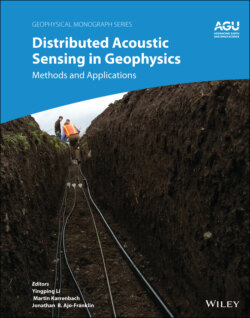Читать книгу Distributed Acoustic Sensing in Geophysics - Группа авторов - Страница 15
ABSTRACT
ОглавлениеThe distributed acoustic sensor (DAS) offers a new versatile tool for geophysical applications. The system allows seismic signals to be recorded along tens of kilometers of optical fiber and over a wide frequency range. In this chapter we introduce the concept of DAS and derive an expression for the system response by modeling the superposition of the coherent backscatter fields along the fiber. Expressions are derived for converting the optical phase to strain rate and equivalent particle motion. We discuss DAS signal processing and denoising methods to deal with the random nature of the Rayleigh scatter signal and to further improve dynamic range and sensitivity. Next we consider DAS parameters such as spatial resolution, gauge length and directionality in comparison with geophones. We present some field trial results that demonstrate the benefits of the DAS for vertical seismic profiling and microseismic detection. Finally we discuss the fundamental sensitivity limit of DAS. We consider how the scattering properties of conventional fiber can be engineered to deliver a step‐change DAS performance, beyond that of conventional geophones and seismometers. Theoretical findings are illustrated by the field data examples, including low‐frequency strain monitoring and microseismic detection.
